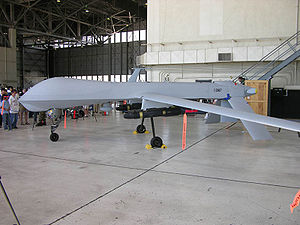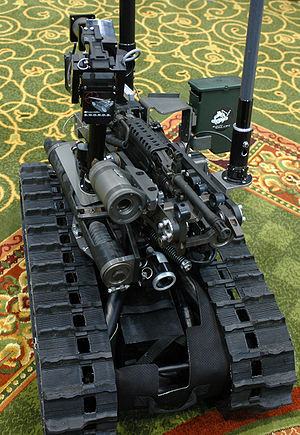Dawn of the Kill-Bots: the Conflicts in Iraq and Afghanistan and the Arming of AI (part 3)
Socrates / Op Ed
Posted on: December 17, 2009 / Last Modified: December 17, 2009
Part 3: The Present — close infantry support and force multiplier
Not surprisingly, once robots began migrating from the production lines to the military, death became not an accidental but deliberate and heavily invested in outcome.
In 2002 the Air Force officially changed the Predator’s designation from RQ-1 (R for reconnaissance) to MQ-1 (M for multi-use). Not just for intelligence gathering anymore, Predators were then officially capable of carrying hell-fire missiles. Even before the official change in its military designation, it was well known that the CIA had already possessed several Predators capable of carrying weapons and conducting bombing raids. So, whatever the official beginning, the Predator was probably the first modern actively armed robotic or unmanned war machine. The first officially reported person to have been deliberately killed by robot was Mohammed Atef. In November 2001 missiles fired from a CIA Predator killed Atef, who was al-Qaeda’s chief of military operations and one of Osama bin Laden’s most important associates.
Currently there are two main suppliers of UGVs for the US military forces: iRobot Inc. and Foster Miller Inc.
Even before deployment to Afghanistan and Iraq the military was testing some limited models and numbers of UGVs that were produced by the above companies with a relatively narrow focus of application consisting mainly of bomb disposal and reconnaissance missions which are particularly dangerous to human soldiers. The active deployment of troops in a hostile theatre of operations only accelerated the large scale introduction of Army-Bots. The Pack-Bot, which was among the first bomb-sniffing robots, was produced by iRobot. Starting out with just a dozen or so units in 2003, by 2008 iRobot has delivered more than 1,500. In its turn, Foster-Miller Inc. started with a modest 162 TALON multi-purpose robots deployed to Iraq and Afghanistan in 2004 and by 2008 grew to over 5,500 units (number debated). Thus together the two companies add up to a total number of over 7,000 UGVs which have been deployed on the battlefield in Iraq and Afghanistan by the US Army and Marine Corps.
Despite the large number of UGVs and, by now, their mundane usage for bomb-sniffing and disposal, their most classified, controversial and most important application is their actual or potential usage as “close infantry support and force multiplier.” What this means is that some of the units are armed with typical infantry weapons and, in certain situations, are being (or at least intended to be) used as soldier replacements. Given their ability to operate, shoot and kill “the enemy” (i.e. humans) and in order to avoid tautology I will occasionally call them Kill-Bots. This will also avoid confusion with the vastly prevalent un-armed bomb-sniffing Army-Bots (be it TALON or PackBot).
The Foster-Miller company is owned by the QinetiQ Group which in its turn is a joint venture between the UK’s Ministry of Defence and US-based holding company the Carlyle Group. While the current deployment, missions and usage of the armed UGVs may have been cloaked in secrecy their production and specifications are not. The first robot fighter introduced by Foster-Miller has been code-named SWORDS, after the acronym for Special Weapons Observation Reconnaissance Detection Systems. It is based on the Talon family robots widely used to disarm bombs and therefore has the same all terrain and weather tracked body/vehicle capable to operate in sand, mud, snow and heavy brush. In addition, the SWORDS Kill-Bot can be fitted with “direct engagement” standard M16, M240, M249 or Barret 50.cal infantry weapons. It has alternate mounts for 40 mm grenade launcher or anti-tank rocket systems. It also has four cameras with night vision and zoom lenses and can travel autonomously through impediments such as barbed wire. Fully loaded the Kill-Bot weighs 196 lb. and can reach speed of 4 mph (6.6 km/h) while its batteries can run from two and a half to four hours depending on load, terrain and mission.
The Kill-Bot costs around $200,000 per unit (versus $120,000 for the general TALONs) and is remotely operated by a soldier-operator via a laptop and a video-game-type joystick.
Details about the missions and usage of the SWORDS are scarce yet the initial tests must have satisfied the military with its performance because Foster-Miller has already produced its upgraded replacement. The second generation Kill-Bot is called MAARS which stands for Modular Advanced Armed Robotic System. In contrast to it SWORDS predecessor the MAARS unit is specifically designed for combat.
The MAARS “war fighter” (as the company promo material calls it) “controls the escalation of force” on the battlefield or in any other applicable situation. It has a much heavier and more durable chassis with easier battery and electronics accessibility. Other improved features include a larger payload bay, higher torque, creating faster ground speeds and improved braking. The complete system weighs about 350 lb. but can still reach speeds of up to 7 mph (almost double the speed of SWORDS).
According to Foster-Miller the missions associated with the MAARS can span the entire spectrum: from non-lethal to fully lethal engagement. In non-lethal mode the main weapon system is pointed down and the robot engages by broadcasting voice and high pitch siren signals or by using its green eye-safe laser – “the Dazzler.” In “less-lethal” mode the MAARS can have its weapon pointed up and engages by employing tear gas, smoke and ultimately warning shots. Finally, the robot can go to full “lethal” mode and can use its M240B medium machine gun (which comes loaded with 400 rounds of 7,62mm ammunition) and a pack of 40mm High Explosive grenades. In such a situation, according to BBC, both kill-bots are more accurate shots than the average soldier because their weapons’ system is mounted on a stable platform and takes aim electronically. Thus, quoting a US officer who helped test the robot,
“It [the Robot] eliminates the majority of shooting errors you [soldiers] have.”
It is important to note that at least at this point the robot does not have the capability to fire autonomously but only after the specific instructions of its remote operator. The reason to keep people controlling the robots rather than making them totally autonomous is so that the human operator has to make the decision and analyze the situation before shots are fired. This is to prevent any accidental shootings attributed to a robot. However, while both current UAVs and UGVs are usually controlled remotely by distant human operators, ultimately the Pentagon would like to give these robots increasing amounts of autonomy, including the ability to decide when to use lethal force. Says Gordon Johnson of the Joint Forces Command at the Pentagon:
“It’s more than just a dream now, today we have an infantry soldier” […] “We give him a set of instructions: if you find the enemy, this is what you do. We give the infantry soldier enough information to recognize the enemy when he’s fired upon. He is autonomous, but he has to operate under certain controls. It’s supervised autonomy. By 2015, we think we can do many infantry missions. […] The American military will have these kinds of robots. It’s not a question of if, it’s a question of when.”
A retired three-star admiral and an industry insider, Joseph W. Dyer, who heads iRobot’s government and industrial division, not only agrees with the feasibility of such prospects but goes as far as to commit to a timeline. Commenting on the androids which the movie I, Robot projected to be produced by around 2030 Dyer said:
“We think that timeline is about right.”
***
End of Part 3 (see Part 1; Part 2; Part 4; Part 5)
Related articles by Zemanta
- Iraq rebels ‘hack into US drones’ (news.bbc.co.uk)
- How Are Robots Being Used In War? (blurtit.com)
- Insurgents Intercept Drone Video in King-Sized Security Breach (wired.com)
- Hacking the Predator drone: Cheaper than dinner and a movie (boingboing.net)
- US to expand eyes in the sky over Afghanistan (seattletimes.nwsource.com)











